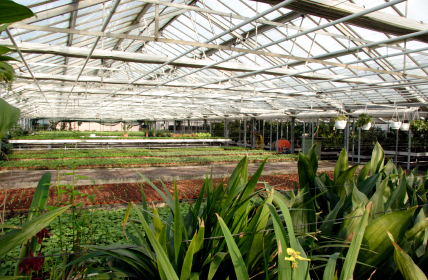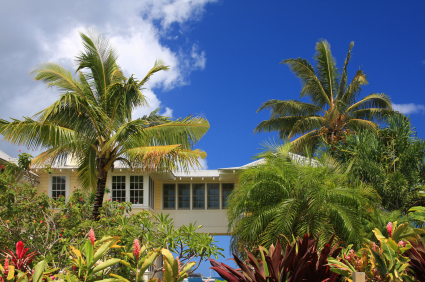The Essential Bromeliad Buyers Guide
Author: Melanie Dearringer9 Comments
Care and Culture, Product Reviews

Outside of tropical regions many people are often introduced to bromeliads in their local garden supply store or even grocery store. Perhaps the bright colors or the uniqueness of these plants caught your attention. Whether you are currently caring for a bromeliad or are thinking about purchasing one, there are a few things you will want to keep in mind.
How to Buy Bromeliads
Most bromeliads found in grocery stores and small garden centers are species in the genus Guzmania. Bromeliads in this genus are known for their very colorful bracts that accompany flowering. These plants are engineered by professional bromeliad growers to be incredibly easy to care for. They can survive with little light and not much water. They will provide their bright colors for a long period of time with relatively little care.
Before purchasing a bromeliad you will want to:
- Check the soil in the container. Is it moist but not soggy? Bromeliads are susceptible to root and crown rot. If they remain sitting in waterlogged potting medium too long, the plant may fall victim to rot and will not last long.
- Examine the leaves. They should be stiff and bright green. Leaves that appear droopy, have any brown spots, or yellowing indicate there is a problem with the plant.
- Inspect the plant for insects. Plant pests can increase at a rapid rate in greenhouse and nursery settings. You’ll want to make sure that your bromeliad is free of bugs or you will run risk of spreading an infestation to your other plants.
It may be tempting to choose the most colorful plant, but plants that are just beginning to show color will last longer. Most bromeliads will only produce one bloom in its lifetime and then begin to focus energy on producing pups. If you want a fresh plant, ask the store when they receive their shipments and come on that day to purchase the best looking plant. Regardless of how particular you are, most popular bromeliads are hardy and will be healthy for a long time. If you have enjoyed your bromeliad and are interested in growing a more challenging variety of bromeliad, the shops listed below are an excellent resource.
Wholesale Bromeliad Nurseries for Professionals

-Most professional nurseries will have bromeliads.
Nurseries, garden shops and interior plantscapers all need to know where to purchase the highest quality bromeliads. Uniformity and predictability, as well as ease of use, are key when searching for wholesale bromeliads.
There are several leading bromeliad wholesalers in the United States. One of the largest is Kent Bromeliad Nursery Inc. Kent nurseries is a 1,000,000 square foot nursery that grows only bromeliads. Kent grows 100 varieties of Guzmania, Vriesea, Tillandsia, Aechmea and Neoregelia. They maintain patents on 25 of the varieties. That means those varieties can only be sold by Kent Bromeliad Nursery. If it is ease of care, and dependability you need, Kent Bromeliads is an excellent choice for wholesale bromeliads.
Kerry’s is another large bromeliad wholesaler. In addition to bromeliads, Kerry’s also sells orchids. Located in Florida, Kerry’s ships nationwide. They grow several varieties of Guzmania, Vriesea, Tillandsia and Aechmea. Kerry’s mechanized process for selecting size and maturity of plant will ensure uniform looking plants.
Retail Bromeliad Shops
Tropiflora is an excellent online source for bromeliad buyers of any interest and skill level. Tropiflora is a bromeliad nursery that has been in business in Florida for over 35 years. They sell other exotic tropical plants in addition to bromeliads. Their bromeliad collection is extensive and they propagate their plants themselves. The webpage is easy to navigate and is organized in several different ways so that anyone can find the bromeliad they are looking for. You can choose to search alphabetically, by genera, by plants that are appropriate for outdoor landscape, mounting plants, terrarium plants, and by other more options as well. Tropiflora also suggests bromeliads for beginners. Tropiflora’s clients include individual collectors, botanical gardens, zoos, public gardens and small retailers. If you are looking for something unique Tropiflora is sure to have what you have been searching for.
Bird Rock Gardens is another nursery that sells bromeliads online. They grow and sell a variety of exotic tropicals, but specialize in Tillandsia. If you are in the Carlsbad, California area you can visit their display gardens. Tillandsia enthusiasts will find something they enjoy growing at Bird Rock Gardens.
Michael’s Bromeliads is a nursery that sells bromeliads both online and through a catalog service. Listed in the catalog are over 1900 species. On its website you’ll find specials on the best current plants available. The online selection is frequently updated and only includes a few species from several genera. If you are looking for a deal on top quality unique bromeliads this is an excellent place for your search. However, if you are looking for a specific variety Michael’s online format is a little less user friendly than Tropiflora. Bromeliad enthusiats who live in Florida can make an appointment to view their vast collection of bromeliads.
Plant Oddities sells strictly Tillandsias. The website has unique glass orbs that can be purchased with Tillandsia plants and without so that you can create your own arrangement. Plant Oddities also sells a large variety of unusual Tillandsias as well as other mounted plant arrangements. The site includes instructions for care and offers supplies necessary for mounting. If you are looking for a unique gift or a new way to display a collection of plants, Plant Oddities offers some excellent ideas.
The Florida Council of Bromeliad Society also links to various bromeliad shops outside of the United States. The sites include locations such as Australia, New Zealand, Singapore, Brazil and the Netherlands.
Landscape Bromeliads

-Bromeliads are a beautiful addition to tropical landscapes.
If you want to grow bromeliads outdoors, it is important to consult with an expert bromeliad grower or a landscape professional. Bromeliads have greatly varied needs when it comes to temperature, water and sun exposure. You must match your available space to the appropriate bromeliad variety.
Regions that drop below freezing for most of the winter will not be able to grow bromeliads outdoors, but containers are an excellent alternative. Plant containers can be placed outside during the warm season and moved to a sheltered space during the winter. The San Francisco Chronicle recently featured a bigeneric bromeliad that can withstand temperatures down to 25 degrees. In California, this hybrid can be purchased at Grand Lake Ace Garden Center in Oakland and Berkeley Horticultural Nursery. There are also other bromeliads, especially Bilbergias, that are also hardy to lower temperatures.
Bullis Bromeliads is a bromeliad nursery that specializes in hybrids that are particularly suited to landscape needs. They have several hybrids that are grown to thrive in full sun in contrast to the fact that most bromeliads need bright, but indirect light. They also sell several salt tolerant varieties.
Whether you are searching for wholesale, landscape, beginner or collector bromeliads, there are a number of both online retailers and physical bromeliad shops that can meet your needs. Always remember to consult professional growers if you are unsure of the maintenance needs of a particular bromeliad species.
Do you have a favorite bromeliad shop or nursery?
Photo credit: Roberto Verzo via http://www.flickr.com/photos/verzo/9348132490/
9 Responses to “The Essential Bromeliad Buyers Guide”
Leave a Reply

Resource Download
Hechtia Care Cheat Sheet
Learn how to care for your Hechtia bromeliad with this quick and easy informational guide.
Learn More
Ask an Expert
Questions about bromeliads?
Our experts love a challenge!
Photo of the Week
Submit your photo to be featured on the blog!
More Photo of the Week Winners
Submit Photo








My husband got me a bromelaid as a surprise. It has a great burgondy color. I repotted, just because I’m never sure if these plants are root-bound, and I want to know they have good, nutrition-filled soil. Now the top 1/3 (where all the color is) is faling off, the bigger, bottom leaves are curling under. I planted it in a hanging basket, with coconut fiber as it’s “pot” so the soil would drain well. HELP! I’m so sad when I look at it, I don’t want it to die. I also removed what I now know is a “pup” when I repotted, and it seems to be doing ok so far……any advice would be greatly appreciated!
Typically the mother will die after a one or possibly a few sets of pups. This is just how it is with bromeliads. It’s great that your pup is doing well!
i have been unable to find instructions concerning fertilizing this plant. What is the recommended fertilizer. what if water in cup becomes murky and calicum deposits appear? I thank you for any assistance you can provide. thank you Lana
A light 20/20/20 fertilizer will work with most bromeliads. You don’t need to do this very much. Maybe once during the growing season.
You can change in the water that builds up in the cup maybe once per month to keep it fresh.
I now have two bromeliads in my basement under a card table with grow lights above the table and orchids on the table. The bromeliads are under the table. I have read several internet sites on bromeliads, and this site has been most informative. It has provided several sources for further information and where I can purchase more species of these beautiful plants. Thank you for your well conceived site. Curtis West
I just received my first bromelaid. It has already one bloom and two “pups” starting. The bloom is about dried out right now…what do I do? Do I have to cut it off or will the whole mother plant die and then what do I do…re-pot it?
Hi,
I was wondering, is there any way of saving the mother plant from dying after she’s had a few sets of pups? My Bromeliad plant has only had 2 pups and the bloom is already losing a lot of colour, but the leaves surrounding the flower seem to be doing ok. Is there anything I can do?
Thanks
I grow my plants ( aechmea, neoregelia and billbergia outside and bring them in during the winter. But I grow many other tropicals which go into dormancy during this time. My question is: do bromeliads go dormant during this time, or do they continue to grow?
Thanks
I saw them growing in the cook island in coconut palm logs and doing quite well. I now have one here in Victoria on Vancouver Island. Would it be alright to put it out in the Spring after all risks of frost are gone?